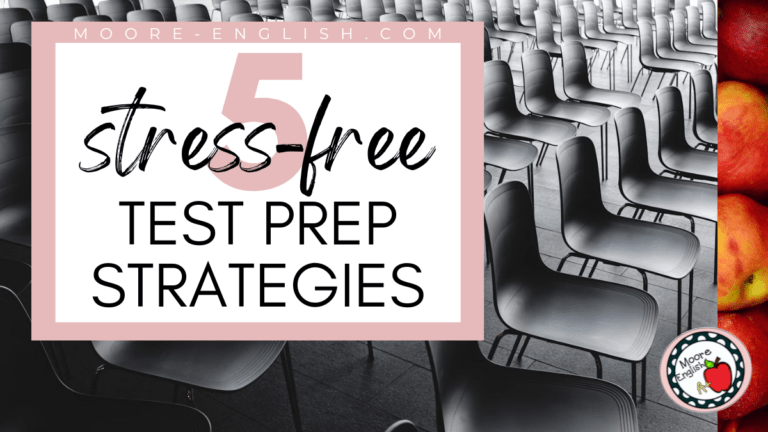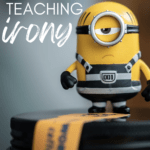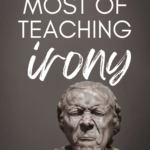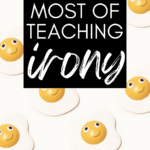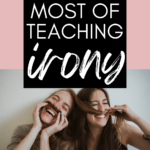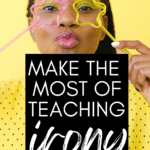I have a confession to make: when I was a new teacher, I had no idea there were different types of irony. In fact, I wasn’t entirely sure what “irony” meant.
Needless to say, the first time I gave a lesson about irony, it flopped. Students were confused about how to define irony and how to differentiate between different types. I was a little confused, too.
After ten years, I’m really happy with my favorite lesson for teaching irony, and I have a collection of text suggestions to use in your classroom.
This post this post may contain affiliate links. Please read the Terms of Use.
Teaching Irony in the Flipped Classroom
In my school district, “irony” and its forms enter instruction in tenth-grade. For my students, sophomore year is usually the first time they hear about irony as a literary term. However, this is rarely the first term we explore, so students are not new to the idea of evaluating an author’s choices.
When I introduce this literary device, I send students home with a Google Slides show that walks them through different examples. (I do not own all of the images or text in the slideshow, so it’s not my intellectual property to share.) Embedded in the slides, I include three Ted-ed videos by Christopher Warner: one for each type.
- What is verbal irony?
- Situational irony: The opposite of what you think
- In on the secret? That’s dramatic irony
Students complete the notes and watch the videos as homework and bring their questions to class the next day. To measure student understanding of the homework, I often use an entrance ticket or bell ringer. Here are some questions I have used:
- Dr. Smyth teaches language arts but struggles with spelling. Why is this ironic?
- While watching a movie, the audience sees the villain hiding behind the door, but the protagonist does not. Why is this ironic?
- Alex walks into class wearing pajamas and has messy hair and toothpaste on their mouth. Upon learning that is it picture day, Alex replies, “Excellent. Just what I wanted to hear.” Why is that ironic?
Poems for Practicing Irony
Oftentimes, poetry is my go-to for practicing with a new concept or skill. Poetry is short, so students can quickly move through several poems in the same amount of time it would take to read a longer text. With this in mind, here are some poetry suggestions:
Poems for Verbal Irony
- First, “I Sit and Sew” by Alice Dunbar-Nelson and “I, being born a woman and distressed” by Edna St. Vincent Millay both use verbal irony to comment on gender roles. The sarcasm in these texts is apparent, so it’s easy for students to pick up on the tone. These are also good poems for introducing feminist criticism or, since they have similar subjects, practicing synthesis thinking. Grab both poems in my 11-12 Point of View Bundle!
- Second, “War is Kind” by Stephen Crane is also easy for students to understand. The speaker’s tone does not share the same snark as Dunbar-Nelson and St. Vincent Millay’s speakers, so this text does a good job exposing students to a different shade of verbal irony. Read it here.
Poems for Situational Irony
- To a certain extent, “War is Kind” also suits situational irony. However, “We Lived Happily During the War” by Ilya Kaminsky is probably a better fit. Since these poems do touch on similar subjects, they can help students have a meaningful conversation about war poetry. Read it here.
- Next, “Richard Cory” by Edward Arlington Robinson provides commentary on a different kind of pain. The situational irony in this poem underlines the tragedy of the poem. The poem’s ending also makes it memorable for students. Read it here.
- Finally, “Long Distance II” by Tony Harrison is a personal favorite. Although the speaker in this poem experiences yet a different kind of pain, the irony in the final lines is touching and relatable. Read it here.
Short Works Recommendations
If you have a little more time, these short works also provide students with an opportunity to evaluate irony. An advantage of a longer text is that students can see how this literary device interacts with other story elements.
- First, “The Yellow Wall-paper” by Charlotte Perkins Gilman is a picture of situational irony. Like “Richard Cory,” this is a text students always remember. The speaker’s eroding mental state is haunting. Read it here.
- Additionally, “Editha” by William Dean Howells features verbal and dramatic irony. The speaker’s attitude toward Editha is nothing short of withering. Similarly, Editha’s own ignorance is both breathtaking and creates spectacular dramatic irony. Read alongside “War is Kind,” these two texts give students perspectives on different shades of Realism. Read it here.
- Next, “Winter Dreams” by F. Scott Fitzgerald is blow after blow of irony. Poor Dexter Green does not ever come close to appreciating the ironies he pursues. Like “Editha,” students often hate Dexter so much that they never forget this short story. Read it here.
- Finally, “Words and Behavior” by Aldous Huxley is actually an essay. On the one hand, Huxley uses sarcasm in his absolute evisceration of propaganda and the ways politicians use language to justify harm. On the the other hand, the essay itself is an expression of situational irony because even as Huxley criticizes the use of persuasive language, he, himself, uses persuasive language. It’s a tricky line to walk and an incredibly challenging text. Read it here.
Long Work Suggestions
When I introduce irony to my sophomores, it’s usually as we are preparing to engage in novel study. By and large, this is my favorite option because students can usually see all forms of irony in one text and see how the author uses it alongside other techniques.
Ironic Novels
- Is there any better novel for discussing irony than Pride and Prejudice? Jane Austen’s classic has every shade of sarcasm and satire. Since this is a novel I usually teach with seniors, this is usually a place where we are reviewing rather than learning about irony for the first time. Check out my Pride and Prejudice Bundle!
- Similarly, The Great Gatsby by F. Scott Fitzgerald is a great vehicle (get it?) for studying irony. From the green light to the yellow car, this novel is a good way to help students see how authors can use irony to enhance symbolism or characterization. All my resources for teaching The Great Gatsby are here.
- Finally, To Kill a Mockingbird by Harper Lee is often the place where I first introduce irony to students. Before or during our reading of this novel, sophomores usually complete my flipped lesson. This novel is a great example of how authors can use tone to provide social commentary. Grab all my To Kill a Mockingbird favorites today!
Drama(tic) Irony
- Plays are the perfect way to study dramatic irony. The Crucible is, perhaps, the ideal way to see dramatic irony at work as Arthur Miller uses it to create tension and heighten the play’s anxieties. The overlap between the play’s themes and the real world allows students to evaluate the ironies in the world around them, too. All of my resources for teaching The Crucible are here.
- Without a doubt, William Shakespeare is one of the giants of drama. While the conclusion of Romeo and Juliet is known for its irony, students can also find plenty to evaluate in Macbeth and Julius Caesar. For my students, I often abridge all of these texts, and I’ve collected them all together in this bundle.
What other strategies or suggestions should we add to our list?





